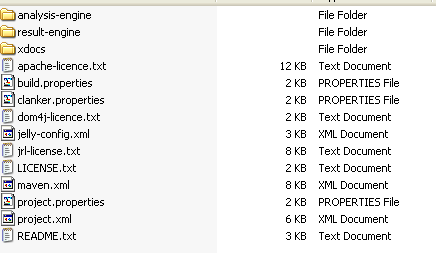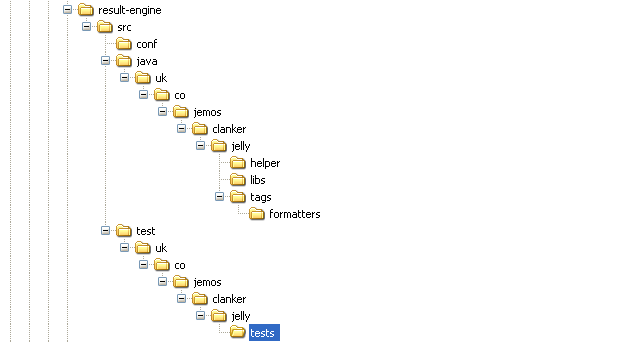Before you start...
Clanker has been built for Java 5 and above and there are two things
to consider:
- Clanker uses the Java compiler, located in the tools package
(com.sun.tools.javac)
- Clanker has been written using Java 5 syntax and supports
Java 5 features, like Annotations and enum types.
The first of these aspects introduces also another important point to keep
in mind when considering this framework: as the Javadoc documentation for
the com.sun.tools.javac API states, [quote]
This is NOT part of any API supported
by Sun Microsystems. If you write code that depends on this,
you do so at your own risk. This code and its internal interfaces
are subject to change or deletion without notice.[/quote], so
be aware that the API, the functionalities and the support may change
without notice. On the other
hand, by using the Java compiler as tool to parse Java sources, Clanker
ensures that the results are compliant with the JSL. I also tested the
analysis engine with Java 6 Beta and it worked fine, although I have to
test the result engine with Java 6 final.
The technologies used by Clanker
| Software | Version | Where to find it | Notes |
|---|
| log4j | 1.2.8 | http://logging.apache.org/log4j/docs/index.html | Log4j is distributed under the
Apache licence |
| tools | 5.0 | http://java.sun.com/ | This is the tools.jar file for JDK 5 which you'll
find under %JAVA_HOME%/lib. tools.jar is distributed
under the JRL licence |
| commons-jelly | 1.0 | http://jakarta.apache.org/commons/ | Commons-Jelly is distributed under the
Apache licence |
| commons-lang | 1.1-dev | http://jakarta.apache.org/commons/ | Commons-Lang is distributed under the
Apache licence |
| commons-logging | 1.1-dev | http://jakarta.apache.org/commons/ | Commons-Logging is distributed under the
Apache licence |
| commons-collections | 3.1 | http://jakarta.apache.org/commons/ | Commons-Collections is distributed under the
Apache licence |
| commons-beanutils | 1.7.0 | http://jakarta.apache.org/commons/ | Commons-Beanutils is distributed under the
Apache licence |
| dom4j | 1.6 | http://www.jemos.co.uk/maven/repository | Dom4j is distributed under the
Dom4j licence |
Clanker uses also Maven 1.x
as its building tool. In order to build Clanker, you will need to install
Maven. Jemos offers a public Maven repository as regards the required
dependencies, so that if you add the locations specified by the
maven.repo.remote property in the build.properties file coming
with the distribution to your list of remote repositories, you can
download the above dependencies directly from Jemos.
Getting the source from a distribution
You can refer here to download
Jemos Clanker.
The source directory structure
Back to the top
Regardless of the way you'll decide to get the source, the folder
structure will appear as follows:
Top level structure:

The top level structure shows the following components:
- analysis-engine folder. This is the folder containing
the analysis engine code. For documentation related to the analysis
engine, please click the subproject documentation on the left menu.
- result-engine folder. This is the folder containing the
result engine, i.e. the set of Jelly tags and Clanker utilities to
make easy for a user to use the analysis tool.
For documentation related to the result engine,
please click the subproject documentation on the left menu.
- apache, dom4j, JRL and Clanker licences, all in form of text
files. Just a reminder: Clanker runs under the
BSD licence
- build.properties This file contains maven repository-related
properties. Those properties are needed by CruiseControl in
order to build the project. As the build process is concerned,
you will need the maven.repo.remote property which, in
addition to Ibiblio, contains links to the Maven remote repository
on Jemos, where the build process will retrieve the dependencies
needed by Clanker. More on how to build in the appropriate
section.
- clanker.properties This file is used by the unit tests in
order to locate the Java source to analyze. It contains only
one property (jemos-clanker.src.dir) which should point to
the location where the Java source files for the unit tests are
located.
- jelly-config.xml This file contains the list of Jelly
Tags used by the result-engine. You can create your own tags
and add their declaration in this file. At runtime, the Clanker
Jelly library will automatically register with the Jelly engine
all the tags declared in this file.
- maven.xml, project.xml Those are the files used by
Maven to build Jemos Clanker.
- project.properties This file contains the multiproject
properties and mainly properties which have to do with the
publishing process.
Analysis Engine structure:

The Analysis Engine structure shows the following components:
- src/conf Here you will find the log4j.properties
file used to configure log4j. This file is used to set the
debugging level when running the unit tests. If the logging
level is set to DEBUG the unit test logging will show
a great deal of information, especially the printout of the
structure created by the analysis engine; if you don't want
to see extensive logging, just set the logging level to
INFO (the default).
- src/java Under this folder you'll find the analysis-engine
source code. For more information on the analysis-engine, please
refer to the analysis-engine documentation.
- src/test Under this folder you'll find the analysis-engine
unit tests source code. For more information on the analysis-engine, please
refer to the analysis-engine documentation.
Result Engine structure:

The Result Engine structure shows the following components:
- src/conf Here you will find the log4j.properties
file used to configure log4j. This file is used to set the
debugging level when running the unit tests.
- src/java Under this folder you'll find the result-engine
source code. For more information on the result-engine, please
refer to the result-engine documentation.
- src/test Under this folder you'll find the result-engine
unit tests source code. For more information on the result-engine, please
refer to the result-engine documentation.
Building Jemos Clanker
Back to the top
In order to build Jemos Clanker you will need the following
pre-requisites:
- Java 5 (Clanker has been built with JDK 1.5.0_06 and it has
not been tested with previous versions of the JDK). Clanker
is not backwards compatible (that means it cannot be built
using Java 2 or earlier versions)
- Maven 1.x (I'm using Maven 1.0.2)
Those are the steps in order to build Clanker:
- Downloads and install the source code. The root folder where
Clanker has been installed will be referred to as
JEMOS_CLANKER_HOME
- Define an environment variable JEMOS_CLANKER_HOME
pointing to the root installation folder. This environment
variable is used to locate some of the files needed by
Clanker: the unit test source files and the
jelly-config.xml file used by the Result engine in
order to locate the configuration file which contains the
declaration of the Jelly tags used by Clanker.
- If you already have a build.properties file
under {user.home} ({user.home} in Windows points to
C:\Documents and Settings\user-name) and you have defined
a maven.repo.remote property there, ensure that the following remote
repository be added to your list: http://www.jemos.co.uk/maven/repository
and be sure that the maven local repository property defined in
JEMOS_CLANKER_HOME/build.properties corresponds to the one (if any)
that you defined under {user.home}/build.properties. If you
haven't got a {user.home}/build.properties file, the one
under JEMOS_CLANKER_HOME shall be enough to build the
application
- Open a command window and point to JEMOS_CLANKER_HOME
- Type
maven multiproject:install
maven -o multiproject:clean multiproject:install




